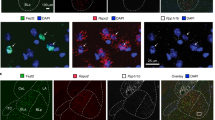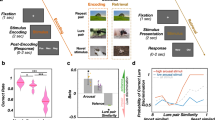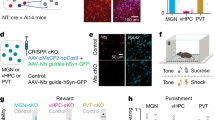Abstract
Emotions generally facilitate memory, an effect mediated by the basolateral amygdala (BLA). To study the underlying mechanisms, we recorded BLA, perirhinal and entorhinal neurons during an appetitive trace-conditioning task. We focused on the rhinal cortices because they constitute the interface between the hippocampus, a mediator of memory consolidation, and the neocortex, the storage site of declarative memories. We found that, after unexpected rewards, BLA activity increased impulse transmission from perirhinal to entorhinal neurons and that this effect decayed as the association between conditioned stimuli and rewards was learned. At this late phase of learning, the BLA effect occurred when the animals were anticipating the reward. By enhancing the processing of sensory cues, the BLA-mediated facilitation of rhinal interactions may explain how the amygdala promotes memory formation in emotional conditions.
This is a preview of subscription content, access via your institution
Access options
Subscribe to this journal
Receive 12 print issues and online access
$209.00 per year
only $17.42 per issue
Buy this article
- Purchase on Springer Link
- Instant access to full article PDF
Prices may be subject to local taxes which are calculated during checkout







Similar content being viewed by others
References
Christianson, S.A. Handbook of Emotion and Memory: Current Research and Theory (Erlbaum, Hillsdale, New Jersey, 1992).
Cahill, L., Babinsky, R., Markowitsch, H.J. & McGaugh, J.L. The amygdala and emotional memory. Nature 377, 295–296 (1995).
Adolphs, R., Cahill, L., Schul, R. & Babinsky, R. Impaired declarative memory for emotional material following bilateral amygdala damage in humans. Learn. Mem. 4, 291–300 (1997).
Adolphs, R., Tranel, D. & Buchanan, T.W. Amygdala damage impairs emotional memory for gist but not details of complex stimuli. Nat. Neurosci. 8, 512–518 (2005).
McGaugh, J.L. et al. Involvement of the amygdaloid complex in neuromodulatory influences on memory storage. Neurosci. Biobehav. Rev. 14, 425–431 (1990).
Roozendaal, B. & McGaugh, J.L. Amygdaloid nuclei lesions differentially affect glucocorticoid-induced memory enhancement in an inhibitory avoidance task. Neurobiol. Learn. Mem. 65, 1–8 (1996).
Phelps, E.A. Human emotion and memory: interactions of the amygdala and hippocampal complex. Curr. Opin. Neurobiol. 14, 198–202 (2004).
Anderson, A.K. & Phelps, E.A. Lesions of the human amygdala impair enhanced perception of emotionally salient events. Nature 411, 305–309 (2001).
Phelps, E.A. & LeDoux, J.E. Contributions of the amygdala to emotion processing: from animal models to human behavior. Neuron 48, 175–187 (2005).
Cahill, L. et al. Amygdala activity at encoding correlated with long-term, free recall of emotional information. Proc. Natl. Acad. Sci. USA 93, 8016–8021 (1996).
Hamann, S.B., Ely, T.D., Grafton, S.T. & Kilts, C.D. Amygdala activity related to enhanced memory for pleasant and aversive stimuli. Nat. Neurosci. 2, 289–293 (1999).
LeDoux, J.E. Emotion circuits in the brain. Annu. Rev. Neurosci. 23, 155–184 (2000).
Cahill, L. & McGaugh, J.L. Mechanisms of emotional arousal and lasting declarative memory. Trends Neurosci. 21, 294–299 (1998).
Packard, M.G., Cahill, L. & McGaugh, J.L. Amygdala modulation of hippocampal-dependent and caudate nucleus-dependent memory processes. Proc. Natl. Acad. Sci. USA 91, 8477–8481 (1994).
Quirarte, G.L., Roozendaal, B. & McGaugh, J.L. Glucocorticoid enhancement of memory storage involves noradrenergic activation in the basolateral amygdala. Proc. Natl. Acad. Sci. USA 94, 14048–14053 (1997).
Ferry, B., Roozendaal, B. & McGaugh, J.L. Role of norepinephrine in mediating stress hormone regulation of long-term memory storage: a critical involvement of the amygdala. Biol. Psychiatry 46, 1140–1152 (1999).
Roozendaal, B., Okuda, S., Van der Zee, E.A. & McGaugh, J.L. Glucocorticoid enhancement of memory requires arousal-induced noradrenergic activation in the basolateral amygdala. Proc. Natl. Acad. Sci. USA 103, 6741–6746 (2006).
Pelletier, J.G., Likhtik, E., Filali, M. & Pare, D. Lasting increases in basolateral amygdala activity after emotional arousal: implications for facilitated consolidation of emotional memories. Learn. Mem. 12, 96–102 (2005).
Seager, M.A., Asaka, Y. & Berry, S.D. Scopolamine disruption of behavioral and hippocampal responses in appetitive trace classical conditioning. Behav. Brain Res. 100, 143–151 (1999).
Ferry, B., Wirth, S. & Di Scala, G. Functional interaction between entorhinal cortex and basolateral amygdala during trace conditioning of odor aversion in the rat. Behav. Neurosci. 113, 118–125 (1999).
Munera, A., Gruart, A., Munoz, M.D. & Delgado-Garcia, J.M. Scopolamine impairs information processing in the hippocampus and performance of a learned eyeblink response in alert cats. Neurosci. Lett. 292, 33–36 (2000).
Ryou, J.W., Cho, S.Y. & Kim, H.T. Lesions of the entorhinal cortex impair acquisition of hippocampal-dependent trace conditioning. Neurobiol. Learn. Mem. 75, 121–127 (2001).
Baxter, M.G. & Murray, E.A. The amygdala and reward. Nat. Rev. Neurosci. 3, 563–573 (2002).
Smith, Y. & Pare, D. Intra-amygdaloid projections of the lateral nucleus in the cat: PHA-L anterograde labeling combined with postembedding GABA and glutamate immunocytochemistry. J. Comp. Neurol. 342, 232–248 (1994).
Pitkanen, A., Pikkarainen, M., Nurminen, N. & Ylinen, A. Reciprocal connections between the amygdala and the hippocampal formation, perirhinal cortex, and postrhinal cortex in rat. A review. Ann. NY Acad. Sci. 911, 369–391 (2000).
Witter, M.P. & Groenewegen, H.J. Connections of the parahippocampal cortex in the cat. III. Cortical and thalamic efferents. J. Comp. Neurol. 252, 1–31 (1986).
Burwell, R.D. & Witter, M.P. Basic anatomy of the parahippocampal region in monkeys and rats. in The Parahippocampal Region. (eds. Witter, M.P. & Wouterlood, F.) Ch. 3, 53–59 (Oxford University Press, New York, 2002).
Suzuki, W.A. & Eichenbaum, H. The neurophysiology of memory. Ann. NY Acad. Sci. 911, 175–191 (2000).
Sutherland, G.R. & McNaughton, B. Memory trace reactivation in hippocampal and neocortical neuronal ensembles. Curr. Opin. Neurobiol. 10, 180–186 (2000).
Squire, L.R., Stark, C.E. & Clark, R.E. The medial temporal lobe. Annu. Rev. Neurosci. 27, 279–306 (2004).
Pelletier, J.G., Apergis, J. & Pare, D. Low-probability transmission of neocortical and entorhinal impulses through the perirhinal cortex. J. Neurophysiol. 91, 2079–2089 (2004).
Pelletier, J.G., Apergis-Schoute, J. & Pare, D. Interaction between amygdala and neocortical inputs in the perirhinal cortex. J. Neurophysiol. 94, 1837–1848 (2005).
Palm, G., Aertsen, A.M. & Gerstein, G.L. On the significance of correlations among neuronal spike trains. Biol. Cybern. 59, 1–11 (1988).
Prut, Y. et al. Spatiotemporal structure of cortical activity: properties and behavioral relevance. J. Neurophysiol. 79, 2857–2874 (1998).
Kajiwara, R., Takashima, I., Mimura, Y., Witter, M.P. & Iijima, T. Amygdala input promotes spread of excitatory neural activity from perirhinal cortex to the entorhinal-hippocampal circuit. J. Neurophysiol. 89, 2176–2184 (2003).
Muir, G.M. & Bilkey, D.K. Theta- and movement velocity-related firing of hippocampal neurons is disrupted by lesions centered on the perirhinal cortex. Hippocampus 13, 93–108 (2003).
Leutgeb, S., Leutgeb, J.K., Moser, M.B. & Moser, E.I. Place cells, spatial maps and the population code for memory. Curr. Opin. Neurobiol. 15, 738–746 (2005).
Buckley, M.J. & Gaffan, D. Perirhinal cortex ablation impairs configural learning and paired-associate learning equally. Neuropsychologia 36, 535–546 (1998).
Bussey, T.J., Saksida, L.M. & Murray, E.A. Perirhinal cortex resolves feature ambiguity in complex visual discriminations. Eur. J. Neurosci. 15, 365–374 (2002).
Murray, E.A. & Mishkin, M. Visual recognition in monkeys following rhinal cortical ablations combined with either amygdalectomy or hippocampectomy. J. Neurosci. 6, 1991–2003 (1986).
Brown, M.W. & Bashir, Z.I. Evidence concerning how neurons of the perirhinal cortex may effect familiarity discrimination. Phil. Trans. R. Soc. Lond. B 357, 1083–1095 (2002).
Witter, M.P., Wouterlood, F.G., Naber, P.A. & Van Haeften, T. Anatomical organization of the parahippocampal-hippocampal network. Ann. NY Acad. Sci. 911, 1–24 (2000).
de Curtis, M. & Pare, D. The rhinal cortices: a wall of inhibition between the neocortex and the hippocampus. Prog. Neurobiol. 74, 101–110 (2004).
Biella, G., Uva, L. & de Curtis, M. Propagation of neuronal activity along the neocortical-perirhinal-entorhinal pathway in the guinea pig. J. Neurosci. 22, 9972–9979 (2002).
Pinto, A., Fuentes, C. & Pare, D. Feedforward inhibition regulates perirhinal transmission of neocortical inputs to the entorhinal cortex: ultrastructural study in guinea pigs. J. Comp. Neurol. 495, 722–734 (2006).
Roesler, R., Roozendaal, B. & McGaugh, J.L. Basolateral amygdala lesions block the memory-enhancing effect of 8-Br-cAMP infused into the entorhinal cortex of rats after training. Eur. J. Neurosci. 15, 905–910 (2002).
Luft, T., Pereira, G.S., Cammarota, M. & Izquierdo, I. Different time course for the memory facilitating effect of bicuculline in hippocampus, entorhinal cortex, and posterior parietal cortex of rats. Neurobiol. Learn. Mem. 82, 52–56 (2004).
Holland, P.C. & Gallagher, M. Amygdala circuitry in attentional and representational processes. Trends Cogn. Sci. 3, 65–73 (1999).
Everitt, B.J., Cardinal, R.N., Parkinson, J.A. & Robbins, T.W. Appetitive behavior: impact of amygdala-dependent mechanisms of emotional learning. Ann. NY Acad. Sci. 985, 233–250 (2003).
Murray, E.A., Graham, K.S. & Gaffan, D. Perirhinal cortex and its neighbours in the medial temporal lobe: contributions to memory and perception. Q. J. Exp. Psychol. B 58, 378–396 (2005).
Acknowledgements
Thanks are due to members of the Paré lab for comments on an earlier version of this paper. This work was supported by RO1 grants MH-073610 and MH-066856 from the US National Institutes of Health to D.P. R.P. was supported by a Fulbright postdoctoral fellowship.
Author information
Authors and Affiliations
Corresponding authors
Ethics declarations
Competing interests
The authors declare no competing financial interests.
Supplementary information
Supplementary Fig. 1
Crosscorrelations between activity of BLA and rhinal neurons. (PDF 490 kb)
Supplementary Fig. 2
Location of significant bins in STJHs. (PDF 342 kb)
Supplementary Fig. 3
BLA-related effect is not observed in rostrocaudal axis. (PDF 247 kb)
Supplementary Fig. 4
Conditional probabilities of entorhinal firing. (PDF 323 kb)
Supplementary Fig. 5
Firing rate of rhinal neurons during trace-condoning. (PDF 420 kb)
Rights and permissions
About this article
Cite this article
Paz, R., Pelletier, J., Bauer, E. et al. Emotional enhancement of memory via amygdala-driven facilitation of rhinal interactions. Nat Neurosci 9, 1321–1329 (2006). https://doi.org/10.1038/nn1771
Received:
Accepted:
Published:
Issue Date:
DOI: https://doi.org/10.1038/nn1771
This article is cited by
-
Cerebellar stimulation prevents Levodopa-induced dyskinesia in mice and normalizes activity in a motor network
Nature Communications (2022)
-
Closed-loop control of gamma oscillations in the amygdala demonstrates their role in spatial memory consolidation
Nature Communications (2019)
-
Long time-scales in primate amygdala neurons support aversive learning
Nature Communications (2018)
-
Updating temporal expectancy of an aversive event engages striatal plasticity under amygdala control
Nature Communications (2017)
-
Engaging in a tone-detection task differentially modulates neural activity in the auditory cortex, amygdala, and striatum
Scientific Reports (2017)



